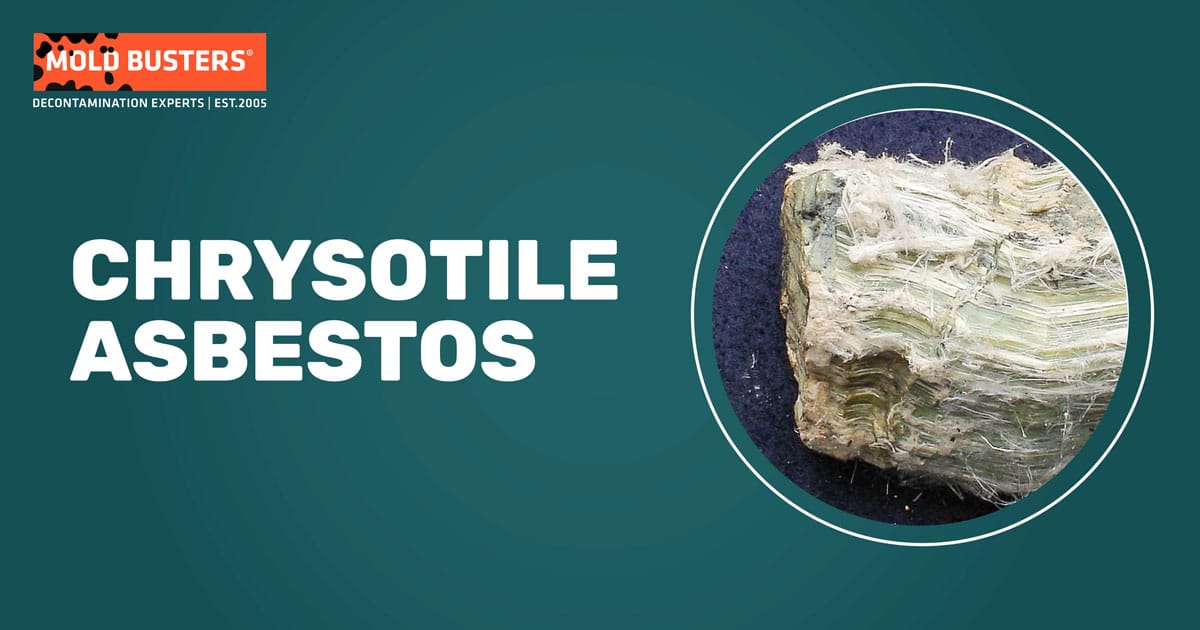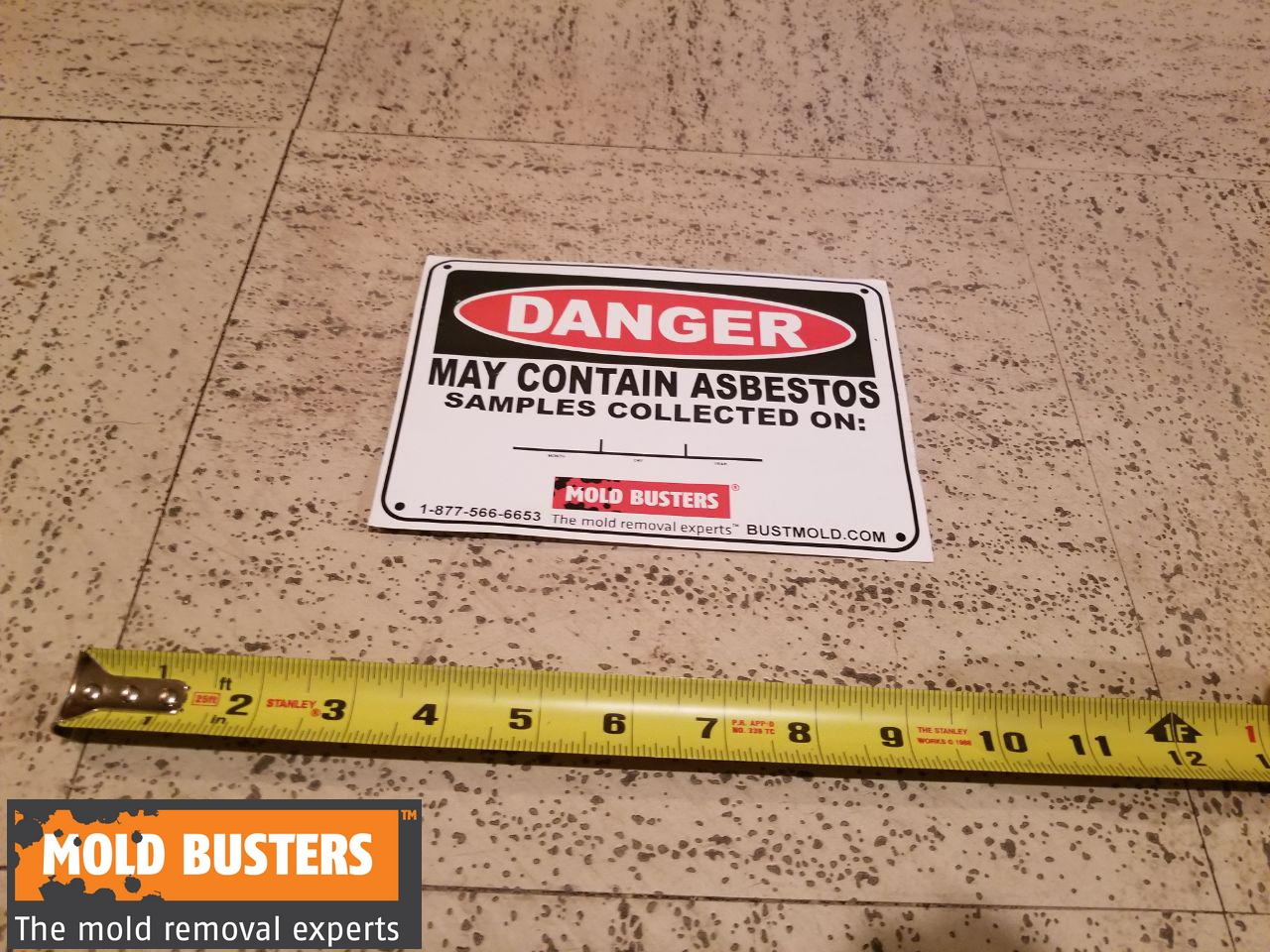Chrysotile Asbestos
There’s a common misconception that some types of asbestos are “safe” for inclusion in homes and businesses. However, with our years of experience in asbestos testing, we at Mold Busters disagree. In fact, so does the World Health Organization (WHO)! Let’s explore why chrysotile asbestos is no better than the rest.
What is chrysotile asbestos?
Asbestos is a family of minerals made up of fibrous crystals with certain traits in common: high tensile strength, heat insulation and resistance to chemicals. It was commonly used as a component of insulation, drywall, roofing materials, break pads, vinyl tiles and many other uses.

In the latter half of the 20th century, evidence stacked up that asbestos was a major cause of various diseases including lung cancer, mesothelioma and a scarring of the lungs that was given the name “asbestosis”. Use of asbestos declined rapidly, with many countries banning the substance, and extensive efforts made to remove asbestos from buildings.
Chrysotile asbestos, also known as “white asbestos”, is a type of asbestos made up of fibres that have a curly or serpentine shape. All other types of asbestos have a needle-like shape. This makes chrysotile asbestos the only member of the “serpentine asbestos” family, while the other family of asbestos with needle-shaped fibres is known as “amphibole asbestos” (comprised of amosite, crocidolite, anthophyllite, tremolite and actinolite).
Is chrysotile asbestos safe?

Some argue that the curly fibres that make up chrysotile are safe, or at least safer than the needle-like fibres of amphibole asbestos.
However, the World Health Organization (WHO) specifically and unequivocally declared that all forms of asbestos—including chrysotile—cause cancer in humans. Likewise, the International Agency for Research on Cancer (IARC) labels chrysotile along with other forms of asbestos a known carcinogen.
When you hear claims of chrysotile being (relatively) safe, consider:
- Chrysotile asbestos historically accounts for 95% of asbestos use world-wide, yet
- Asbestos exposure is the leading cause of work-related deaths in Canada—causing more deaths than highway accidents, chemical exposure and fires combined.
Reports defending chrysotile asbestos are typically funded by the asbestos industry, while credible independent sources like the WHO and IARC conclude that chrysotile asbestos causes cancer and other diseases, just like other forms of asbestos.

Is chrysotile safer than amphibole asbestos?
There is considerable debate in the scientific community about just how dangerous chrysotile asbestos or serpentine asbestos is relative to amphibole asbestos. Some argue that the curly fibres of the serpentine asbestos family aren’t as harmful to the body as the needle-like fibres of amphibole asbestos.
Indeed, some studies do suggest that it takes less exposure to amphibole asbestos to create the same risk of certain diseases compared to chrysotile asbestos. However, it’s important to remember that many of these studies were funded by the chrysotile asbestos industry, and need to be viewed with skepticism.
It’s also important to remember that even if amphibole asbestos is more dangerous than chrysotile asbestos, chrysotile asbestos is still dangerous as well. Indeed, many sources regard chrysotile asbestos as being just as dangerous as amphibole asbestos. Whoever you believe, chrysotile asbestos is known to be a carcinogen and a leading cause of on-the-job illness and fatality. It is decidedly not safe.
Is chrysotile asbestos still used and where?
More than 50 countries have banned the use of chrysotile along with all other forms of asbestos. However, chrysotile remains in use in many countries, particularly in the developing world.
Nowadays, chrysotile asbestos is primarily used as a component in cement (90%), brake pads for cars and other friction materials (7%) with just 3% going to other uses.
Before you assume that chrysotile asbestos “locked” into cement is innocuous, consider: cement pipes made with asbestos can transfer asbestos into the water they carry, which can lead to asbestos being ingested when people drink that water.

Is chrysotile asbestos still used in Canada?
Starting in the 1980s, Canada started phasing out use of other forms of asbestos, but chrysotile asbestos remained legal. However, by 2011 the last two chrysotile asbestos mines in Canada closed down, and in 2018 Canada officially banned all forms of asbestos, including chrysotile.
Despite the ban, asbestos products are still found in buildings and other structures, remnants of the fairly recent past when chrysotile asbestos was still a legal substance.
What materials contain chrysotile asbestos?
Chrysotile asbestos was a common component of a variety of products, including:
- Fireproofing and insulation materials,
- Cement, drywall, roofing, vinyl tiles and other construction materials,
- Brake pads, gaskets and other mechanical components.

Although in Canada and many countries, chrysotile asbestos is no longer being used in these products, it can still be found in building materials and other products made before the ban took place.
What are safe levels of chrysotile asbestos?
The World Health Organization and other experts agree: there is no threshold below which exposure to chrysotile asbestos in considered “safe”.
Even low levels of exposure are associated with elevated risk of cancer.
What are the risks and dangers of chrysotile asbestos exposure?
There are two main ways chrysotile asbestos poses a risk to your health: you might inhale asbestos through air contaminated by loose asbestos fibres, or you might ingest it. Asbestos is sometimes mixed in with concrete, and asbestos fibres in concrete pipes can get into the water system and be ingested in the water you drink. You can also swallow bits of asbestos when tiny fibres coughed up after breathing it in mix with your saliva.
Naturally enough, since exposure comes from breathing in or swallowing asbestos, illnesses associated with exposure to chrysotile asbestos are primarily diseases of the lung and chest cavity. These include:
- lung cancer: one of the most common and deadliest forms of cancer;
- mesothelioma: asbestos exposure is the primary source of this cancer of the linings of the organs of the chest and abdomen;
- asbestosis: a scarring of the lungs which makes breathing difficult;
- various other diseases of the chest cavity such as folded lung syndrome and diffuse pleural thickening, which can result in decreased lung capacity and difficulty breathing.
How to identify chrysotile asbestos?
Asbestos can be found in many construction materials that may have been used in your home or workplace. Some of these substances might be exposed and in plain sight, such as vinyl tiles or popcorn ceiling treatment.
However, asbestos may also have been used in parts of the building that are not readily seen or detected: in the walls, attic, roofing materials or as insulating material around ventilation pipes, etc.

For safe and reliable detection of asbestos in your home or where you work, we recommend hiring experts to inspect the property for you. Mold Busters offers our own asbestos testing service.
If you live or work in a region we serve, we will be happy to inspect your property for asbestos and advise on remediation if needed.
When should you test for chrysotile asbestos?
Of course, if your house or workplace is older, or you see any substances that are liable to contain asbestos, you’ll definitely want to have the property tested for asbestos. In fact, any time you are looking to buy or move into a property, asbestos testing is a good idea.
Health Canada additionally advises to arrange for asbestos testing before any of the following:
- renovating or remodelling,
- performing demolitions,
- constructing additions.
Suspect asbestos if you have vermiculite insulation
Health Canada also notes that asbestos is especially common in vermiculite insulation, a type of loose insulation popular in pre-1990s construction. Often used to insulate attics, vermiculite insulation was prone to falling into wall cavities as well.
If you detect or suspect presence of vermiculite insulation in your home, do not inspect or disturb it yourself. Avoid exposure to the insulation, and call in an expert to perform asbestos testing, and to remove the insulation if asbestos is detected.
How can I remove chrysotile asbestos?
As with infestations of mold in the household, handling and removing a toxic substance such as chrysotile asbestos can directly expose you to the very thing you want to get rid of.
Additionally, chrysotile asbestos fibres might get distributed into your environment by the very act of removing them. We therefore strongly urge you: do not attempt to remove chrysotile asbestos yourself. Hire an asbestos remediation professional.
Conclusion
No amount or type of asbestos is safe, including chrysotile asbestos. Despite being banned in Canada and over 50 other countries, the legacy of chrysotile asbestos use persists, with asbestos still present in many homes and workplaces.
Exposure to asbestos represents a life-threatening risk of cancer and other diseases of the lungs and chest.
If you suspect asbestos in your home or workplace, play it safe and call the experts to safely test for and, if required, remove any asbestos that might be present. For more information, see our section on Asbestos Testing.
Resources

Get Special Gift: Industry-Standard Mold Removal Guidelines
Download the industry-standard guidelines that Mold Busters use in their own mold removal services, including news, tips and special offers:
Published: May 2, 2023 Updated: June 16, 2023

Written by:
John Ward
Account Executive
Mold Busters
Fact checked by:
Michael Golubev
CEO
Mold Busters
